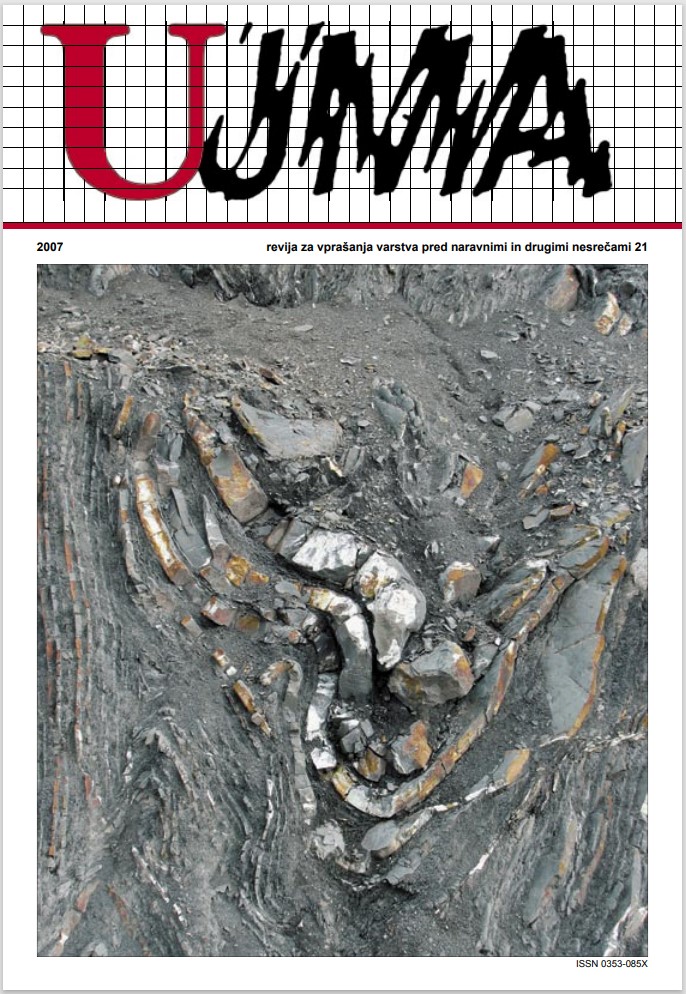MICROTREMORS – A METHOD FOR ASSESSING THE EFFECTS OF LOCAL GEOLOGICAL STRUCTURE ON SEISMIC GROUND MOTION AND BUILDING VULNERABILITY
Abstract
Several earthquakes in recent decades have shown that the impact of local geological structure (site effects) on seismic ground motion was often underestimated; the effects of the earthquake were therefore greater than expected. The situation in which both the fundamental frequencies of sediments and structures are similar and resonance occurs is particularly dangerous. Methods of assessing the effects of local geology have included the use of microtremors in the last decade. The method is based on measurements of ambient vibration of natural and artificial origin with a three-component sensor. The spectral ratio between the records on horizontal and vertical components gives the fundamental frequency of soft sediments deposited over hard bedrock. By measurements taken inside buildings, the main building frequency in longitudinal and transverse directions and, consequently, the range of increased vulnerability, is determined. Comparison of the fundamental frequency map of sediments and measurements inside buildings allows quantitative microzonation of urban areas and the identification of areas in which there is a danger of soil-structure resonance. Microtremor investigations are carried out in Slovenia within the framework of an international project of the NATO Science for Peace programme. A new microzonation of Ljubljana will be performed with measurements in a very dense grid of 200 m x 200 m. In the Bovec basin, where site effects were very prominent during the damaging 1998 and 2004 earthquakes, we found out that relative high damage to some buildings and areas was caused by soil-structure resonance effects. In Ilirska Bistrica, which is one of the most seismically active regions in Slovenia, we also established that most buildings damaged during major earthquakes are located in areas characterised by the fundamental frequency of soil coinciding with the range of the fundamental building frequencies.
References
Bard, P. Y., 1999. Microtremor measurements: a tool for site effect estimation? V: Irikura, K., Kudo, K., Okada, H., Sasatami, T. (ur.): The effects of surface geology on seismic motion. Balkema, 1251–1279.
Bonnefoy-Claudet, S., Cotton, F., Bard, P. Y., Cornou, C., Ohrnberger, M., Wathelet, M., 2006. Robustness of the H/V ratio peak frequency to estimate 1D resonance frequency. 3rd symp. on effects of surface geology on seismic motion, 361–370.
Borcherdt, R. D., 1970. Effects of local geology on ground motion near San Francisco bay. Bull. Seism. Soc. Am., 60/1, 29–61.
Gallipoli, M. R., Mucciarelli, M., Castro, R. R., Mochavesi, G., Contri, P., 2004. Structure, soil-structure response and effects of damage based on observations of horizontal-to-vertical spectral ratios of microtremors. Soil Dynamics and Earthquake Engineering, 24, 487–495.
Gosar, A., Stopar, R., Car, M., Mucciarelli, M., 2001. The earthquake on 12 April, 1998 in Krn mountains (Slovenia): ground motion amplification study using microtremors and modelling based on geophysical data. Journal of applied geophysics 47/2, 153– 167.
Gosar, A., 2007. Microtremor HVSR study for assessing site effects in the Bovec basin (NW Slovenia) related to 1998 Mw5.6 and 2004 Mw5.2 earthquakes. Engineering geology (v tisku).
Kramer, S. L., 1996. Geotechnical earthquake engineering. Prentice Hall, 653 str.
Kreslin, M., Dolšek, M., Fajfar, P., 2006. Matematično modeliranje in analiza armiranobetonske stavbe po EC8. Gradbeni vestnik, 55, 141–152.
Lapajne, J., 1970. Seizmična mokrorajonizacija Ljubljane, geofizikalne raziskave, neobjavljeno poročilo. Geol. zav. Ljubljana, 16. str.
Lapajne, J., 2005. Potres 12. julija 2004 v Zgornjem Posočju in karta potresne nevarnosti – vpliv zmanjšanja potresne odpornosti in usmerjenosti pretrga. Ujma 19, 74–81.
Lenart, A., 2006. Merjenje seizmičnega nemira na Galjevici v Ljubljani za oceno ojačenja nihanja tal ob potresu. Seminarska naloga, NTF, 12. str.
Lermo, J., Chavez-Garcia, F. J., 1993. Sitte effect evaluation using spectral ratios with only one station. Bull. Seism. Soc. Am., 83/5, 1574–1594.
Medvedev, S. V., 1965. Inženjerska seizmologija. Građevinska knjiga, 268 str., Beograd.
Mucciarelli, M., Gallipoli, M. R., 2001. A critical review of 10 years of microtremor HVSR technique. Boll. Geof. Teor. Appl., 42, 255–266.
Nakamura, Y., 1989. A method for dynamic characteristics estimation of subsurface using micro-tremor on the ground surface. Q. R. Railway Tech. Res. Inst.
Nakamura, Y., 2000. Clear identification of funda mental idea of Nakamura’s technique and its applications. 12WCEE, New Zeland.
Nogoshi, M., Igarashi, T., 1971. On the amplitude characteristics of microtremor (part 2). Jour. Seism. Soc. Japan, 24, 26–40.
Pitilakis, K., 2004. Site effects. V: Ansal, A. (ur.): Recent advances in earthquake geotechnical engineering and microzonation. 139–197.
Reiter, L., 1990. Earthquake hazard analysis. Columbia University Press, 254 str.
SESAME 2004. Guidelines for the implementation of the H/V spectral ratio technique on ambient vibrations: measurements, processing and interpretation, 62 pp., http://sesame-fp5.obs.ujf-grenoble. fr/Delivrables/Del-D23-HV_User_Guidelines.pdf
Vidrih, R., Godec, M., 2006. Potresi na Ilirskobistriškem. Ujma, 20, 73–85.
Zupančič, P., Šket-Motnikar, B., Gosar, A., Prosen, T., 2004. Karta potresne mikrorajonizacije Mestne občine Ljubljana. Potresi v letu 2002, 32–54.
Downloads
Published
Issue
Section
License

This work is licensed under a Creative Commons Attribution-NonCommercial-NoDerivatives 4.0 International License.
The articles are made available to the public under Creative Commons Attribution-NonCommercial-NoDerivatives 4.0 International (CC BY-NC-ND 4.0).


